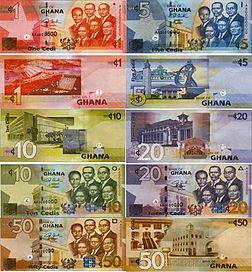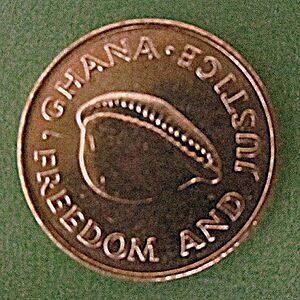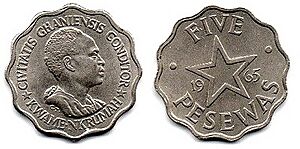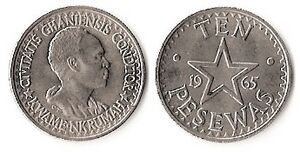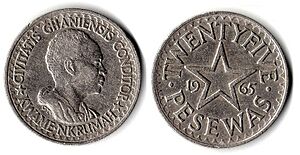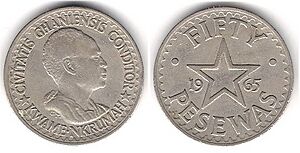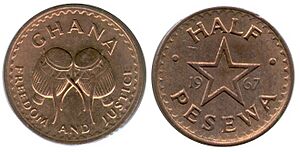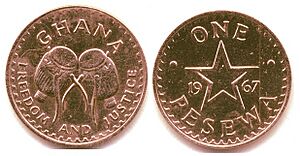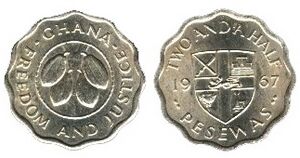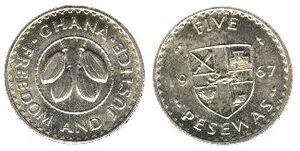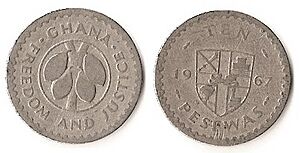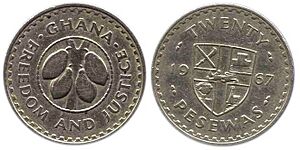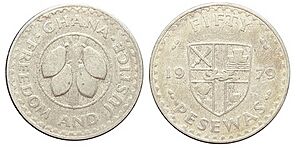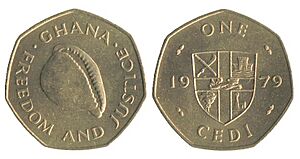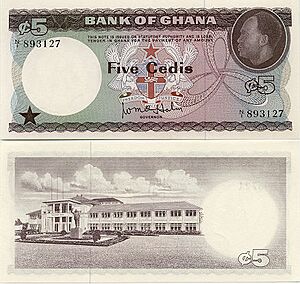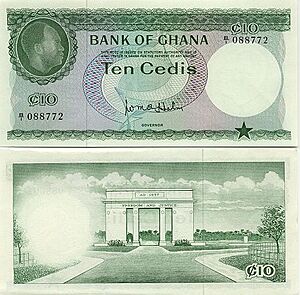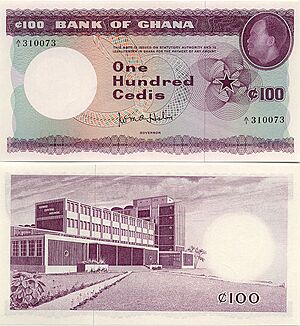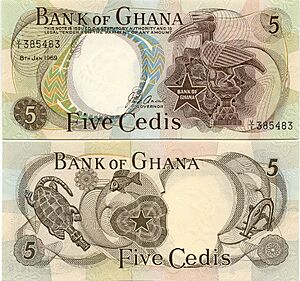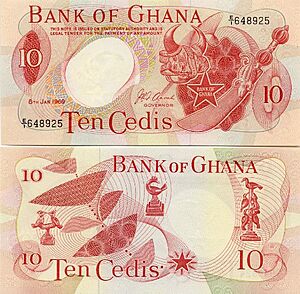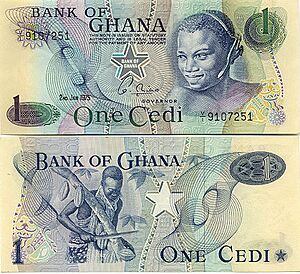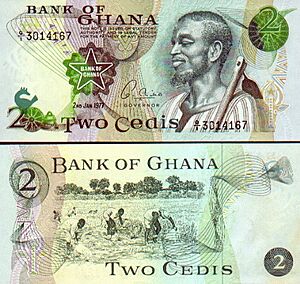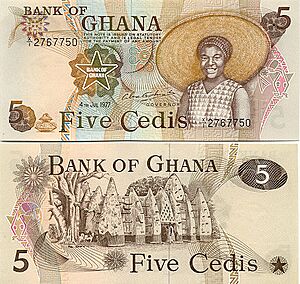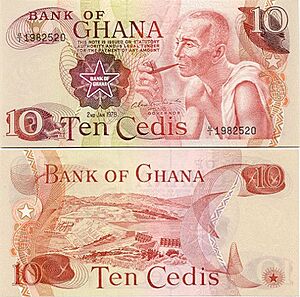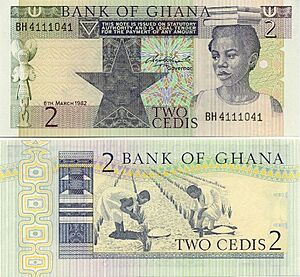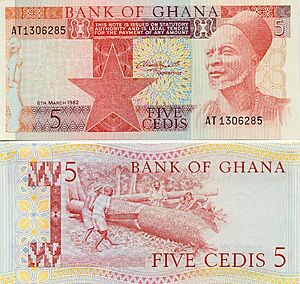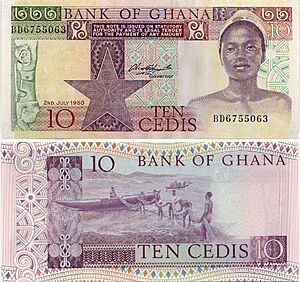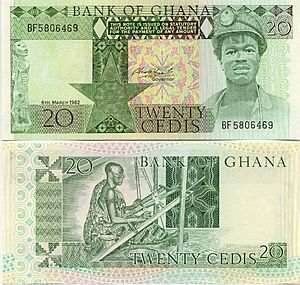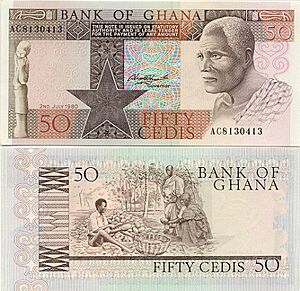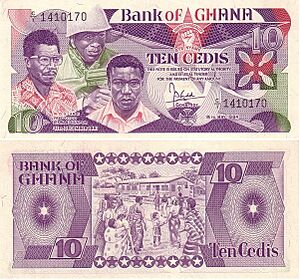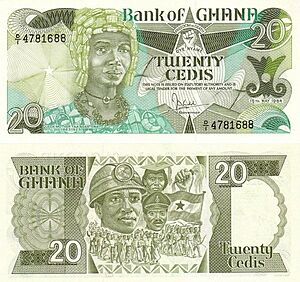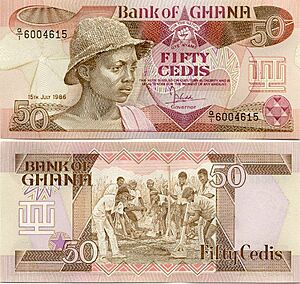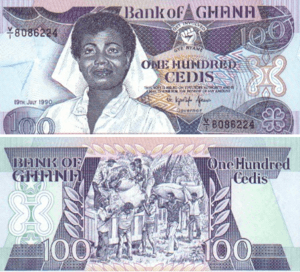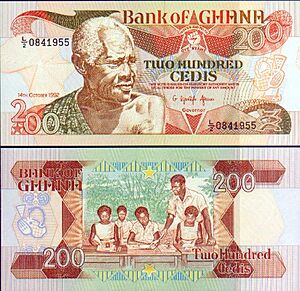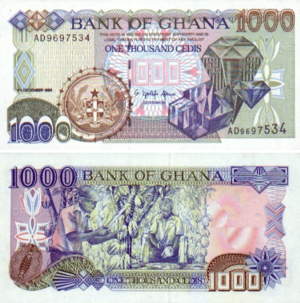Ghanaian cedi facts for kids
Quick facts for kids Ghanaian cedi |
|||
|---|---|---|---|
|
|||
| ISO 4217 Code | GHS | ||
| User(s) | |||
| Inflation | 17% | ||
| Source | Ghana Statistical Service | ||
| Subunit | |||
| 1⁄100 | pesewa | ||
| Symbol | GH₵ | ||
| pesewa | Gp | ||
| Plural | cedis | ||
| pesewa | pesewas | ||
| Coins | 10Gp, 20Gp, 50Gp, GH₵1, GH₵2 | ||
| Rarely used | 1Gp, 5Gp | ||
| Banknotes | GH₵1, GH₵2, GH₵5, GH₵10, GH₵20, GH₵50, GH₵100, GH₵200 | ||
The cedi (pronounced like "SEE-dee") is the official money used in Ghana. It is the main type of money that can be legally used in Ghana today. One Cedi is split into one hundred smaller parts called Pesewas (Gp).
After Ghana became independent, it stopped using the British West African pound. This was the money used by British colonies in the area. Ghana's first own money was the Ghanaian pound (used from 1958 to 1965).
In 1965, Ghana decided to move away from the British money system. They chose to use the decimal system, which is based on units of ten. The new money was called the Cedi (used from 1965 to 1967). Ghana's first President, Kwame Nkrumah, introduced Cedi banknotes and Pesewa coins in July 1965. These replaced the old Ghanaian pounds, shillings, and pence. One Cedi was worth about eight shillings and four pence. This meant one pesewa was equal to one old penny.
After a military takeover in February 1966, the new leaders wanted to remove Nkrumah's face from the money. So, the "new Cedi" was introduced in 1967. It was worth 1.2 of the first Cedis. This made it equal to half of a British pound. Over many years, high inflation made the new Cedi lose a lot of its value. By 2007, the largest banknote, the 20,000 note, was only worth about US$2. Because of this, the "new Cedi" was slowly replaced in 2007 by the "Ghana Cedi." The exchange rate was 1 Ghana Cedi for every 10,000 old Cedis. By removing four zeros, the Ghana Cedi became one of the highest-valued money units in Africa. However, it has since lost more than 90% of its value.
Contents
What Does "Cedi" Mean?
The word cedi comes from the Akan language. It means "cowry shell." Long ago, cowry shells were used as money in the area that is now Ghana. These shells are not originally from West Africa. They came from the Indian Ocean through trade with Arab merchants starting in the 14th century. The first modern coins used in the Gold Coast were made in 1796. But cowry shells were still used alongside coins and gold as money until 1901.
History of the Cedi
The First Cedi (1965–1967)
The first Cedi was introduced in 1965. It replaced the Ghanaian pound. For every 1 pound, you would get 2.4 Cedis. This also meant that 1 pesewa was equal to 1 old penny. The first Cedi was linked to the British Pound sterling. So, 2.4 Cedis were worth £1.
The Second Cedi (1967–2007)
The first Cedi was replaced in 1967 by a "new Cedi." This new Cedi was worth 1.2 times the first Cedi. This change made it easier to convert the money using the decimal system, where 2 new Cedis equaled 1 pound. It also allowed the government to remove Kwame Nkrumah's picture from the coins and banknotes.
The second Cedi was first linked to the British pound, with ₵2 equaling £1. But within a few months, its value dropped. It was then linked to the U.S. dollar at ₵1 for $0.98. The value of the Cedi continued to drop over the years.
In the early 1980s, the government tried to control prices. This made people buy and sell goods on the "black market" instead of official stores. On the black market, one U.S. dollar was worth about 120 Cedis by 1983. But the official bank rate was still ₵2.80 for $1.00. Eventually, Ghana had to let the Cedi's value slowly drop. This process ended in 1990 when the Cedi's value was allowed to change freely against other currencies.
Inflation continued to be a big problem. By July 2007, one U.S. dollar was worth about ₵9500. This led to the introduction of the third Cedi.
In 1979, the government changed the banknotes. New banknotes were given out, but for every 10 old notes, people only got 7 new ones. Coins and bank accounts were not affected.
Another change happened in 1982. The ₵50 note, which was the largest, was taken out of circulation. People could exchange their ₵50 notes for smaller notes or coins without losing value. But many Ghanaians who had saved a lot of ₵50 notes were afraid to exchange them all. So, some people simply burned their money. This was done to try and stop the black market. After this, the ₵20 note became the largest, but it was only worth about $0.35 U.S.
Because of these changes and high inflation (around 100% each year), people started to lose trust in their own money. Some transactions began to be done using foreign money, even though it was against the law. Other everyday transactions even went back to barter, where people traded goods directly instead of using money.
New coins were introduced in the 1990s: 10, 20, 50, and 100 Cedis in 1991, and 200 and 500 Cedis in 1996. These coins were used until 2007. However, the 10 and 20 Cedi coins were not used much because their value was so small.
The Third Cedi (2007–Present)
Because of the very high inflation, the second Cedi was worth very little. So, in 2007, the government decided to remove four zeros from the currency. This new money was officially called the "Ghanaian Cedi" (GH₵). For a few months in 2007, both the old and new Cedis were legal to use. By the end of 2007, most of the old money had been taken out of circulation. From January 2008, old banknotes could only be exchanged at banks.
On May 14, 2010, a GH₵2 banknote was released. This was to help people have a middle value note and reduce the need to print so many GH₵1 notes. This new note also celebrated 100 years since the birth of Kwame Nkrumah, Ghana's first president.
Due to continued high inflation and the Cedi losing value, the Bank of Ghana announced new 2-cedi coins and new 100 and 200-cedi banknotes on November 29, 2019. The existing 1 and 2 cedi banknotes are still legal, but they will slowly be replaced by coins to save money.
The third Cedi has continued to lose value since it was introduced. In 2014, its value dropped to a fourth of its original worth. The value stabilized for a short time at the end of 2014 because Ghana was getting help from the IMF.
The one pesewa coin is rarely used today because it can't buy much. In September 2021, the Bank of Ghana started taking GH₵1 and GH₵2 notes out of circulation. They want people to use the coins instead.
By August 2022, high inflation caused the Cedi's value to drop even more, with GH₵10 equaling about US$1. In September 2022, the yearly inflation rate was 37.2%, the highest since 2001. By October 2022, the Cedi became the worst-performing currency in the world. It had lost 60% of its value against the U.S. dollar since the end of 2021.
Coins of Ghana
The Bank of Ghana has been making all Ghanaian coins since 1958. Besides the coins used every day, they have also made special "commemorative" coins for important events.
Only coins that have been widely used are listed here. The "years of issue" means the coin was made more than once during that time, not necessarily every single year. Sometimes, new coins are kept back and released years later. This means you might find both old, worn-out coins and shiny new ones from the same year in circulation. The Bank of Ghana has not said if they hold back coins or if they stamp new coins with old dates.
First Cedi Coins (1965–1967)
| First Cedi Coins | |||||||||
|---|---|---|---|---|---|---|---|---|---|
| Image | Value | Description | Date of Issue | ||||||
| Front & Back | Front | Back | Metal | Weight | Diameter | Edge | |||
| 5 pesewas | Kwame Nkrumah (Words:) CIVITATIS GHANIENSIS CONDITOR (the Founder of Ghana) KWAME NKRUMAH |
Five-pointed star (Words:) The value of the coin & 1965 |
Copper-nickel | 4.1 g | 22 mm | Smooth | 19 July 1965 | ||
| 10 pesewas | 3.2 g | 20 mm | Milled | ||||||
| 25 pesewas | 8.65 g | 27.4 mm | |||||||
| 50 pesewas | 13.9 g | 32 mm | Reeded | ||||||
Second Cedi Coins
| Second Cedi Coins | |||||||||
|---|---|---|---|---|---|---|---|---|---|
| Image | Value | Description | Years of Issue | ||||||
| Front & Back | Front | Back | Metal | Weight | Diameter | Edge | |||
| 1⁄2 pesewa | Adowa drums (Words:) GHANA FREEDOM AND JUSTICE |
Five-pointed star (Words:) The value of the coin & The year it was made |
Bronze | 2.9 g | 20.2 mm | Smooth | 1967 | ||
| 1 pesewa | 5.72 g | 25.47 mm | 1967–1979 | ||||||
| 2+1⁄2 pesewas | Cacao fruits (Words:) GHANA FREEDOM AND JUSTICE |
The shield from Ghana's coat of arms (Words:) The value of the coin & The year it was made |
Copper-nickel | 3.2 g | 19.5 mm | 1967 | |||
| 5 pesewas | 2.85 g | 19 mm | Reeded | 1967–1975 | |||||
| 10 pesewas | 5.6 g | 23.5 mm | 1967–1979 | ||||||
| 20 pesewas | 11.2 g | 28 mm | |||||||
| 50 pesewas | 12.5 g | 32 mm | Milled | 1979 | |||||
| 1 cedi | Cowry shell (Words:) GHANA FREEDOM AND JUSTICE |
Brass | 11.9 g | 30 mm | Smooth | ||||
Third Cedi Coins
The new coins are 1 pesewa (worth 100 old cedis), 5 pesewas (500 old cedis), 10 pesewas (1,000 old cedis), 20 pesewas (2,000 old cedis), 50 pesewas (5,000 old cedis), 1 cedi (10,000 old cedis) and 2 cedis (20,000 old cedis).
Banknotes of Ghana
The Bank of Ghana has been printing all Ghanaian banknotes since 1958. Many banknotes have been changed slightly over the years. This is part of the ongoing effort to fight against fake money. Also, the signature on the notes changes when a new person becomes the head of the Bank of Ghana. These changes happen often and are not listed here. The "years of issue" means the banknote was printed more than once during that time, not necessarily every single year.
First Cedi Banknotes (1965–1967)
| First Cedi Banknotes | ||||||
|---|---|---|---|---|---|---|
| Image | Value | What's on it | Date of Issue | |||
| Front & Back | Front | Back | ||||
| 1 cedi | Kwame Nkrumah | Bank of Ghana building | 19 July 1965 | |||
| 5 cedis | Supreme Court building | |||||
| 10 cedis | Black Star Gate | |||||
| 50 cedis | Seashore with palm trees | |||||
| 100 cedis | Kumasi Central Hospital | |||||
| 1,000 cedis (Only for bank transfers) |
Black Star | Bank of Ghana building | ||||
Second Cedi Banknotes (1967–2007)
1967 to 1979
| Second Cedi – 1st Series | ||||||
|---|---|---|---|---|---|---|
| Image | Value | What's on it | Years of Issue | |||
| Front & Back | Front | Back | ||||
| 1 cedi | Cocoa pods | Shield and sword | 1967–1971 | |||
| 5 cedis | Animal carvings | Animal carvings | 1967–1969 | |||
| 10 cedis | Art projects | Small statues | 1967–1970 | |||
| Second Cedi – 2nd Series | ||||||
|---|---|---|---|---|---|---|
| Image | Value | What's on it | Years of Issue | |||
| Front & Back | Front | Back | ||||
| 1 cedi | Young girl | Cocoa farmer | 1973–1978 | |||
| 2 cedis | Farmer | Fishermen | 1972–78 | |||
| 5 cedis | Woman | Larabanga Mosque | 1973–1978 | |||
| 10 cedis | Pipe smoker | Akosombo Dam | ||||
1979 to 2007
| Second Cedi – 3rd Series | ||||||
|---|---|---|---|---|---|---|
| Image | Value | What's on it | Years of Issue | |||
| Front & Back | Front | Back | ||||
| 1 cedi | Young man | Basket weaver | 1979–1982 | |||
| 2 cedis | Schoolgirl | Field workers | ||||
| 5 cedis | Old man | Lumberers | ||||
| 10 cedis | Young woman | Fishermen | ||||
| 20 cedis | Miner | Kente weaver | ||||
| 50 cedis (No longer used after 1982) |
Old man | Cocoa farmers | 1979–1980 | |||
| Second Cedi – 4th Series | ||||||
|---|---|---|---|---|---|---|
| Image | Value | What's on it | Years of Issue | |||
| Front & Back | Front | Back | Start | End | ||
| 10 cedis | W. O. II Larbi, Fred Otoo, E. Kwasi Nukpor | Rural bank building | 1984 | 1984 | ||
| 20 cedis | Queen Mother Yaa Asantewaa | Miner, army officer, student, demonstrators | 1986 | |||
| 50 cedis | Young man | Workers drying grain | 1983 | |||
| 100 cedis | Woman | Loading produce | 1991 | |||
| 200 cedis | Old man | Teacher and students | 1993 | |||
| 500 cedis | Black star, fist, and "Gye Nyame" symbol | Cocoa and miner | 1986 | 1994 | ||
| 1,000 cedis | Diamonds | Cocoa harvest | 1991 | 2003 | ||
| 2,000 cedis | Adomi Bridge | Fishermen | 1994 | 2006 | ||
| 5,000 cedis | Coat of arms of Ghana | Cargo ships and logs | ||||
| 10,000 cedis | The Big Six | Black Star Gate | 2002 | |||
| 20,000 cedis | Ephraim Amu | National Theatre of Ghana | ||||
Third Cedi Banknotes (2007–Present)
| Third Cedi Banknotes | ||||||||||||
|---|---|---|---|---|---|---|---|---|---|---|---|---|
| Image | Value | Size | Main Colour | What's on it | First Issued | |||||||
| Front & Back | Front | Back | ||||||||||
| 1 cedi | 137 × 65 mm | Red | The Big Six, Black Star Gate | Akosombo Dam | 3 July 2007 | |||||||
| 2 cedis | 140 × 67 mm | Beige | Kwame Nkrumah | Parliament House | 14 May 2010 | |||||||
| 5 cedis | 141 × 68 mm | Blue | The Big Six, Black Star Gate | University of Ghana, The Balme Library | 3 July 2007 | |||||||
| 5 cedis | 147 × 68 mm | Blue | James Emman Kwegyir Aggrey | Kwame Nkrumah vessel in Tweneboa, Enyenra, and Ntomme oil fields | 7 March 2017 (special issue) 4 August 2017 (regular issue) |
|||||||
| 10 cedis | 145 × 71 mm | Yellow-green | The Big Six, Black Star Gate | Bank of Ghana | 3 July 2007 | |||||||
| 20 cedis | 149 × 74 mm | Purple | Supreme Court | |||||||||
| 50 cedis | 153 × 77 mm | Brown | Christiansborg Castle | |||||||||
| 100 cedis | 157 x 80 mm | Cyan | The Big Six, Black Star Gate | Inside the Parliament of Ghana | 2 December 2019 | |||||||
| 200 cedis | 161 x 83 mm | Orange | The Big Six, Black Star Gate | Jubilee House | 2 December 2019 | |||||||
How the Cedi's Value Has Changed
The tables below show how many Ghanaian Cedis you would need to get one U.S. dollar over time.
| Date | Cedi per U.S$. | Date | Cedi per U.S$. |
|---|---|---|---|
| First Cedi | |||
| 1965 | 0.824 | 1967 | 0.714 |
| Second Cedi | |||
| 1970s | around 1.000 | 1980 | 2.80 (Bank rate) (around 20 on Black market) |
| 1983 | 30.00 (Bank rate) (around 120 on Black market) (Oct 83) |
1984 | 35.00 (Mar 84) 38.50 (Aug 84) 50 (Dec 84) |
| 1985 | 50–60 | 1986 | 90 |
| 1987 | 150–175 | 1988 | 175–230 |
| 1989 | 230–300 | 1990 | 300–345 |
| 1991 | 345–390 | 1992 | 390–520 |
| 1993 | 555–825 | 1994 | 825–1050 |
| 1995 | 1050–1450 | 1996 | 1450–1750 |
| 1997 | 1750–2250 | 1998 | 2250–2350 |
| 1999 | 2350–3550 | 2000 | 3550–6750 |
| 2001 | 6750–7300 | 2002 | 7300–8450 |
| 2003 | 8450–8850 | 2004 | 8850–8900 |
| 2005 | 8900–9500 | 2006 | 9500–9600 |
| 2007 | 9300–9600 | ||
| Year | January 1 | May 1 | September 1 | October 1 |
|---|---|---|---|---|
| 2008 | 0.930 | 1.005 | 1.155 | 1.159 |
| 2009 | 1.265 | 1.460 | 1.465 | 0.688 |
| 2010 | 1.430 | 1.425 | 1.440 | 1.429 |
| 2011 | 1.486 | 1.496 | 1.535 | 1.597 |
| 2012 | 1.639 | 1.855 | 1.932 | 1.893 |
| 2013 | 1.905 | 1.974 | 2.150 | 2.179 |
| 2014 | 2.353 | 2.823 | 3.723 | 3.219 |
| 2015 | 3.215 | 3.847 | 3.831 | 3.780 |
| 2016 | 3.809 | 3.789 | 3.963 | 3.963 |
| 2022 | 6.200 | 7.550 | 10.05 | 13.100 |
| 2023 | 11.000 | 12.100 | 14.01 | 15.243 |
| Current GHS exchange rates | |
|---|---|
| From Google Finance: | AUD CAD CHF EUR GBP HKD JPY USD XOF |
| From Yahoo! Finance: | AUD CAD CHF EUR GBP HKD JPY USD XOF |
| From XE.com: | AUD CAD CHF EUR GBP HKD JPY USD XOF |
| From OANDA: | AUD CAD CHF EUR GBP HKD JPY USD XOF |
| From fxtop.com: | AUD CAD CHF EUR GBP HKD JPY USD XOF |
Images for kids
See Also
- Economy of Ghana
- E-Cedi
- Older Ghanaian currencies:
- Money cowry
- Akan goldweights (gold dust)
- Gold Coast ackey
- British West African pound
- Ghanaian pound


